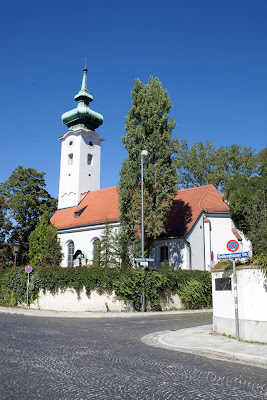Arriving at the scene I framed the church in the viewfinder to check out the possible areas of light and dark. having done that I put the camera down and used my spot meter to evaluate the levels of brightness in the shot. I determined to use ISO 100 and f/11, so needed simply the shutter speed needed. The brightest part of the church, the white wall, metered at 1/1000s whilst the darkest, a patch of deep shade, metered at 1/25s. This was a range of just over 5 stops, halfway between the two readings would be 1/160s. Now this is clearly not going to be the correct exposure for the situation as it is not even an average of the scene, simply the median value between light and dark.
I then metered the incident light using the meter and arrived at an exposure reading of 1/250s, about 1/2 stop brighter. Using the cameras own meter set to evaluative, the scene metered at 1/125s a full stop brighter than the correct exposure. In this case the camera appears to be trying to brighten the deeper shadows at the expense of blowing out the whites. This is the sequence of shots without any modification, all at ISO 100, f/11
1/125s
1/160s
1/250s
None of the shots are particularly poor, but the final one is by far the more satisfying to me, the tonal range is stronger and I like the colour contrast punch that it delivers. Clearly it can be improved and I have done so in the following image, the same photo as that immediately above, but developed in Lightroom:
The second part of this exercise to create a similar frame in B&W is not practical with a digital camera. The text suggests simply converting to B&W in software. However, doing so removes information from the image and in effect starts to obscure detail. Perhaps this is an area where the course could use a rewrite.
Having learned that neither the cameras evaluative exposure measurement, nor the median calculation from spot metering were satisfactory, I decided to leave my camera set to the "ideal" exposure for the light, kept the 35mm prime lens mounted and went to explore a little. Normally I set the camera to evaluative metering, today this would not be the case.
These first two shots directly compare the "correct" exposure above with the evaluative. Again I find the more constrasty scene better, although some work would be needed to lift the shadows a little.
Just to check that all was well I took the above to check the metering and no problem. I then set out to shoot some very high contrast scenes still metering for the sunlit parts of the scene.
I find the images better represent what I was seeing than they would with an evaluative metering of the scene. Clearly I have significant areas of darkness, but nothing that could not be corrected in post processing. Once I lose the highlights I have lost the shot completely, large areas of white do not make for great photographs.
Once again as I walked through the park, shots in sun or with reflections came out well, although needing some work (none of these photographs has been processed in any way). Looking for areas of very distinct contrast I shot the following two images
The second photo was interesting to shoot, I tried to capture groups of people passing from the lighted path into the underpass in which I was standing.
Finally I came to a large and rather sad block of marble, a monument to a group of students who plotted against Hitler and paid the ultimate price. By correctly metering the scene I have been able to render this as black rather than a dirty grey had I used the cameras in built metering.
I finish this exercise once more walking back through the park, just after lunchtime. People living in small apartments near the park, use the Englischer Garten as their own garden, sunbathing, picnicing, and having some fun. Look closely and you will see that wearing clothing is far from compulsary in Germany.
Key Learning:
- Think harder about exposure, do not slavishly follow the matrix metering.
- The greatest contrast can be delivered by using incident light metering and then adjusting from that point.



















No comments:
Post a Comment